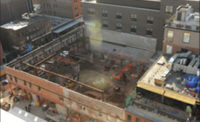Gov. Andrew Cuomo’s office has begun to specify a slew of major infrastructure projects statewide that will receive funding under the newly created NY Works Task Force economic development program. The program, which the governor calls the “centerpiece” of his $132.6-billion budget that passed last week, includes an investment of $1.2-billion to accelerate road and bridge improvements.
The program will accelerate state investments in improvements to hundreds of miles of roads, bridges as well as parks and historic sites. Investments announced the week of April 2 include $460 million to replace New York City’s Kosciuszko Bridge; $145 million for bridge deck and steel replacement of the Albany-Rensselaer I-90 bridge over the Hudson River; $1.5 million for deck replacement of the Syracuse I-81 bridge over East Calthrop Avenue; and $16 million for parapet work at 16 locations that span nine bridges on Long Island’s Meadowbrook and Southern State Parkways.
The budget also includes $770 million in direct funding to support the Metropolitan Transportation Authority’s five-year capital plan. The first two years of the agency’s $22.2-billion capital plan were funded at $9.1 billion. The governor says the budget will help MTA to obtain the remaining $13.1 billion needed for the capital plan and to complete some of the largest construction projects in the history of New York. These include four mega projects already under way: the Second Avenue Subway; East Side Access for the Long Island Rail Road; the Fulton Street Transit Center; and the No. 7 subway line extension to the West Side.
Industry groups, including the Associated General Contractors Association of New York State, welcome the program. The budget will help provide for much-needed and long-overdue work on the state’s bridges and roadways, says Mike Elmendorf, president and CEO of AGC NYS. “You are seeing a real focus on infrastructure from the governor and the legislature,” he says. He adds that his group will continue to urge the federal government to approve the Railroad Rehabilitation and Improvement Financing Program loan, which he says will enable the MTA to restructure its finances.
Meanwhile, 1.8 million more residents and 1.6 million more jobs are expected to be in the MTA service territory by 2035, Joseph Lhota, MTA chairman and CEO, told attendees at a New York Building Congress meeting on April 3. With the NYC region’s growth, “the subway needs to expand to meet this demand,” he says. “We don’t have peak periods anymore. Traffic on the subway system is pretty much all the way through,” including at nights, weekends and off-peak times.
However, he does not support a suggestion once made by Mayor Michael Bloomberg to extend the No. 7 subway service under the Hudson River to New Jersey, as it would be too expensive. “Of course, New Jersey would like to have it, because they think they’ll be able to get across the river at $2.25,” Lhota says. “It’s not going to happen. Not in our lifetime, not in anybody’s lifetime.”
Later that same day, however, the mayor shot back a response. He said he hoped it would happen “in somebody’s lifetime.”


Post a comment to this article
Report Abusive Comment